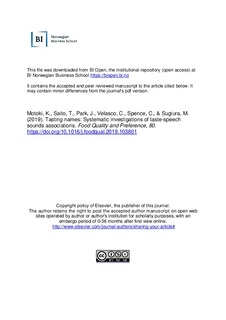Tasting names: Systematic investigations of taste-speech sounds associations
Journal article, Peer reviewed
Accepted version
Permanent lenke
http://hdl.handle.net/11250/2630181Utgivelsesdato
2019Metadata
Vis full innførselSamlinger
- Publikasjoner fra CRIStin - BI [1015]
- Scientific articles [2181]
Originalversjon
Food Quality and Preference, 80 (March),Sammendrag
Product names can be developed to effectively convey specific sensory attributes to the consumer. Most of the previous research on crossmodal correspondences has shown that people selectively associate words (e.g., ‘Maluma’, ‘Takete’) with taste attributes. To provide practical insights for naming new products in the food industry, it is important to obtain a more nuanced understanding concerning those properties of speech sounds (i.e., vowels, consonants) influencing people’s taste expectations. In this study, we investigated taste-speech sound correspondences by systematically manipulating the vowels and consonants comprising fictitious brand names. Based on the literature on crossmodal correspondences and sound symbolism, we investigated which vowels/consonants contribute more to the association between speech sounds and tastes (sweet/sour/salty/bitter). Across three experiments, we systematically varied vowels (front: [i][e], back: [a][u][o]), and affricate consonants (e.g., fricative: [f][s], stop: [p][t]) as well as voiced/voiceless consonants (e.g., voiced: [b][d], voiceless: [f][k]). Japanese participants were presented with brand names and had to evaluate the taste that they expected the product to have. The results revealed that: (1) front (back) vowels increased expected sweetness (bitterness), (2) fricative (stop) consonants increased expected sweetness (saltiness/bitterness), (3) voiceless (voiced) consonants increased expected sweetness/sourness (saltiness/bitterness). Moreover, consonants, which were pronounced first in the brand names, exerted a greater influence on expected taste than did the vowels. Taken together, these findings help advance theoretical foundations in sound-taste correspondences research as well as provide practical contributions to the food practitioners to develop predictive product names.

